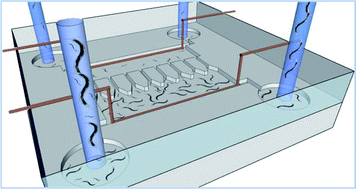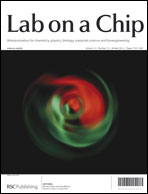Electrical sorting of Caenorhabditis elegans†
Abstract
The nematode (worm) C. elegans is one of the widely studied animal model organisms in biology. It develops through 4 larval stages (L1–L4) in 2 to 3 days before becoming a young adult. Biological assays involving C. elegans frequently require a large number of animals that are appropriately staged and exhibit a similar behaviour. We have developed a new method to synchronize animals that relies on the electrotactic response (electric field-induced motion) of C. elegans to sort them in parallel based on their age, size and phenotype. By using local electric field traps in a microfluidic device, we can efficiently sort worms from a mixed culture in a semi-continuous flow manner (with a minimum throughput of 78 worms per minute per load-run) and obtain synchronized populations of animals. In addition to sorting larvae, our device can also distinguish between young and old adults efficiently. Unlike fluorescent based sorting systems that use active imaging based feedback, this method is passive and automatic and uses the innate behaviour of the worm. Considering that the entire procedure takes only a few minutes to run and is cost-effective, it promises to simplify and accelerate experiments requiring homogeneous cultures of worms as well as to facilitate isolation of mutants that have abnormal electrotaxis. More importantly, our method of isolating and separating worms using locomotion as a defining characteristic promises development of advanced microfluidics-based systems to study the neuronal basis of movement-related defects in worms and facilitate high-throughput chemical screening and


 Please wait while we load your content...
Please wait while we load your content...